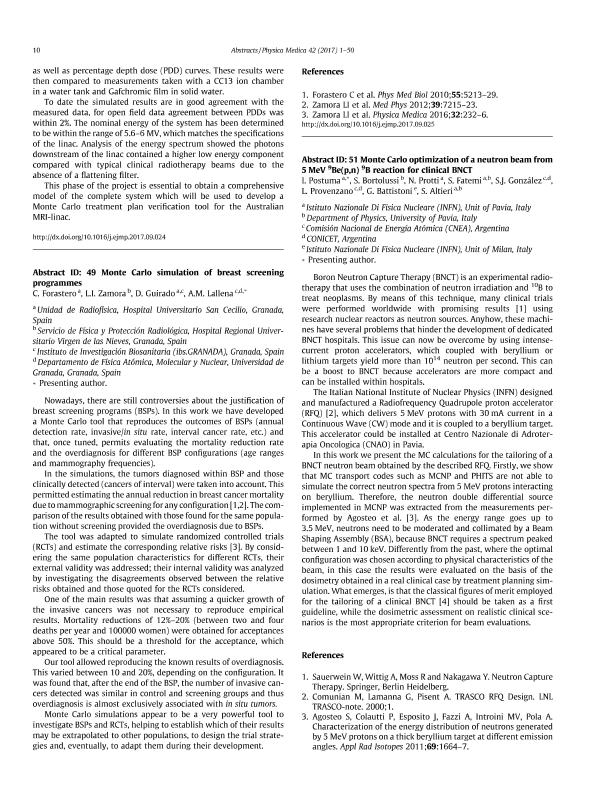Artículo
Abstract ID: 51 Monte Carlo optimization of a neutron beam from 5 MeV 9 Be(p,n) 9 B reaction for clinical BNCT
Postuma, I.; Bortolussi, S.; Protti, N.; Fatemi, S.; González, Sara Josefina ; Provenzano, Lucas
; Provenzano, Lucas ; Battistoni, G.; Altieri, S.
; Battistoni, G.; Altieri, S.
 ; Provenzano, Lucas
; Provenzano, Lucas ; Battistoni, G.; Altieri, S.
; Battistoni, G.; Altieri, S.
Fecha de publicación:
10/2017
Editorial:
Istituti Editoriali e Poligrafici Internazionali
Revista:
Physica Medica
ISSN:
1120-1797
Idioma:
Inglés
Tipo de recurso:
Artículo publicado
Clasificación temática:
Resumen
Boron Neutron Capture Therapy (BNCT) is an experimental radiotherapy that uses the combination of neutron irradiation and 10B to treat neoplasms. By means of this technique, many clinical trials were performed worldwide with promising results [1] using research nuclear reactors as neutron sources. Anyhow, these machines have several problems that hinder the development of dedicated BNCT hospitals. This issue can now be overcome by using intense-current proton accelerators, which coupled with beryllium or lithium targets yield more than 1014 neutron per second. This can be a boost to BNCT because accelerators are more compact and can be installed within hospitals.The Italian National Institute of Nuclear Physics (INFN) designed and manufactured a Radiofrequency Quadrupole proton accelerator (RFQ) [2], which delivers 5 MeV protons with 30 mA current in a Continuous Wave (CW) mode and it is coupled to a beryllium target. This accelerator could be installed at Centro Nazionale di Adroterapia Oncologica (CNAO) in Pavia.In this work we present the MC calculations for the tailoring of a BNCT neutron beam obtained by the described RFQ. Firstly, we show that MC transport codes such as MCNP and PHITS are not able to simulate the correct neutron spectra from 5 MeV protons interacting on beryllium. Therefore, the neutron double differential source implemented in MCNP was extracted from the measurements performed by Agosteo et al. [3]. As the energy range goes up to 3.5 MeV, neutrons need to be moderated and collimated by a Beam Shaping Assembly (BSA), because BNCT requires a spectrum peaked between 1 and 10 keV. Differently from the past, where the optimal configuration was chosen according to physical characteristics of the beam, in this case the results were evaluated on the basis of the dosimetry obtained in a real clinical case by treatment planning simulation. What emerges, is that the classical figures of merit employed for the tailoring of a clinical BNCT [4] should be taken as a first guideline, while the dosimetric assessment on realistic clinical scenarios is the most appropriate criterion for beam evaluations.
Palabras clave:
Bnct
,
Monte Carlo
,
Acelerator Based Neutron Beam
,
Bsa
Archivos asociados
Licencia
Identificadores
Colecciones
Articulos(SEDE CENTRAL)
Articulos de SEDE CENTRAL
Articulos de SEDE CENTRAL
Citación
Postuma, I.; Bortolussi, S.; Protti, N.; Fatemi, S.; González, Sara Josefina; et al.; Abstract ID: 51 Monte Carlo optimization of a neutron beam from 5 MeV 9 Be(p,n) 9 B reaction for clinical BNCT; Istituti Editoriali e Poligrafici Internazionali; Physica Medica; 42; 10-2017; 10-11
Compartir
Altmétricas



